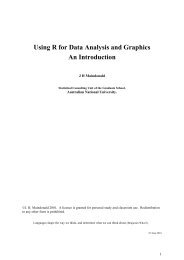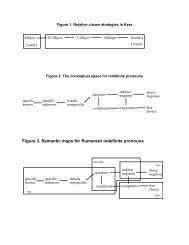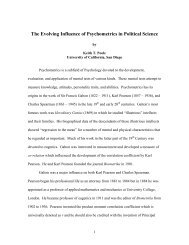The Relationship Between the Aldrich-McKelvey Scaling Solution ...
The Relationship Between the Aldrich-McKelvey Scaling Solution ...
The Relationship Between the Aldrich-McKelvey Scaling Solution ...
Create successful ePaper yourself
Turn your PDF publications into a flip-book with our unique Google optimized e-Paper software.
ALMCKID.DOC<br />
<strong>The</strong> <strong>Relationship</strong> <strong>Between</strong> <strong>the</strong> <strong>Aldrich</strong>-<strong>McKelvey</strong> <strong>Scaling</strong> <strong>Solution</strong> and<br />
and <strong>the</strong> Individual Differences Problem<br />
Keith T. Poole<br />
University of Houston<br />
In <strong>the</strong> individual differences problem, <strong>the</strong> individuals report judged<br />
similarities/dissimilarities between objects/stimuli. Let<br />
be <strong>the</strong> reported dissimilarity by<br />
individual i (i=1,...,p) between stimulus j and stimulus m (j,m=1,...,q) and let z jk be <strong>the</strong> true<br />
location of <strong>the</strong> jth stimulus on <strong>the</strong> kth dimension (k=1,...,s). <strong>The</strong> reported dissimilarity is assumed<br />
to be <strong>the</strong> sum of <strong>the</strong> true dissimilarity and a noise term:<br />
*2<br />
d ijm<br />
s<br />
*2 2 2<br />
ijm ∑ ik jk jm ijm<br />
k=1<br />
d = w (z - z ) + u<br />
(1)<br />
where<br />
2<br />
w ik<br />
is <strong>the</strong> weight individual i places on dimension k (hence <strong>the</strong> term "individual<br />
differences").<br />
In <strong>the</strong> classic Carroll-Chang (1970) solution for <strong>the</strong> individual differences problem, <strong>the</strong> p q<br />
by q D * matrices of dissimilarites (taken as squared distances) are double-centered and an<br />
alternating least squares procedure is used to estimate <strong>the</strong> q by s matrix Z and <strong>the</strong> p q by q diagonal<br />
matrices W i .<br />
<strong>The</strong> purpose of this paper is to show an alternative solution for <strong>the</strong> individual differences<br />
problem using a method developed by <strong>Aldrich</strong> and <strong>McKelvey</strong> (1977) for scaling individuals'<br />
reported perceptions of <strong>the</strong> locations of stimuli along a scale with labeled endpoints.<br />
In particular, let z ji be <strong>the</strong> perceived location of stimulus j by individual i. <strong>Aldrich</strong> and<br />
<strong>McKelvey</strong> assume that <strong>the</strong> individual reports a noisy linear transformation of <strong>the</strong> true location of<br />
<strong>the</strong> stimulus; that is<br />
1
α i + β i z ji = z j + u ij (2)<br />
where u ij satisfies <strong>the</strong> usual Gauss-Markov assumptions of zero mean, constant variance across<br />
stimuli and individuals, and zero covariance.<br />
Let ẑ<br />
j<br />
be <strong>the</strong> estimated location of stimulus j and let<br />
ˆα<br />
i<br />
and ˆβ i<br />
be <strong>the</strong> estimates of α and β.<br />
Define<br />
ˆ<br />
e<br />
i<br />
= α<br />
i<br />
+ βiz ji<br />
- z j<br />
ˆ<br />
ˆ<br />
(3)<br />
<strong>Aldrich</strong> and <strong>McKelvey</strong> set up <strong>the</strong> following Lagrangean multiplier problem:<br />
p q q<br />
2<br />
⎡<br />
2<br />
⎤<br />
L(α<br />
i, β<br />
i, z<br />
j, λ<br />
1, λ ˆ ˆ<br />
2) = e<br />
i<br />
+ 2λ1 z<br />
j<br />
+ λ2⎢ z<br />
j<br />
- 1⎥<br />
i=1 j= 1 ⎣ j=<br />
1 ⎦<br />
∑ ∑ ∑ (4)<br />
that is, minimize <strong>the</strong> sum of squared error subject to <strong>the</strong> constraints that <strong>the</strong> estimated stimuli<br />
coordinates have zero mean and sum of squares equal to one. Define <strong>the</strong> q by 2 matrix X as<br />
X =<br />
i<br />
⎡1 z1i<br />
⎤<br />
⎢<br />
1 z<br />
⎥<br />
⎢ 2i ⎥<br />
⎢ . . ⎥<br />
⎢ ⎥<br />
⎢ . . ⎥<br />
⎢ . . ⎥<br />
⎢ ⎥<br />
⎢⎣<br />
1 zqi<br />
⎥⎦<br />
<strong>the</strong>n <strong>the</strong> solution for <strong>the</strong> individual transformations is simply <strong>the</strong> "least-squares regression of <strong>the</strong><br />
reported on <strong>the</strong> actual (unknown) positions of <strong>the</strong> candidates" (<strong>Aldrich</strong> and <strong>McKelvey</strong>, p. 115).<br />
That is,<br />
⎡ˆα<br />
⎤<br />
⎢ ⎥<br />
⎣<br />
ˆβ<br />
i ⎦<br />
−<br />
[ ] 1<br />
i ′ ′<br />
i i i<br />
= X X X zˆ<br />
(5)<br />
where ẑ is <strong>the</strong> q by 1 vector of <strong>the</strong> actual (unknown) positions of <strong>the</strong> candidates:<br />
2
ẑ =<br />
⎡ẑ1<br />
⎤<br />
⎢<br />
ẑ<br />
⎥<br />
⎢ 2 ⎥<br />
⎢ . ⎥<br />
⎢ ⎥<br />
⎢ . ⎥<br />
⎢ . ⎥<br />
⎢ ⎥<br />
⎢⎣<br />
ẑq<br />
⎥⎦<br />
To get <strong>the</strong> solution for ẑ , define <strong>the</strong> q by q matrix A as:<br />
A =<br />
⎡<br />
⎢<br />
⎣<br />
p<br />
∑<br />
i=1<br />
−1<br />
⎤<br />
X<br />
i(X′ iX i) X′<br />
i⎥<br />
⎦<br />
<strong>Aldrich</strong> and <strong>McKelvey</strong> show that <strong>the</strong> partial derivatives for <strong>the</strong> ẑ<br />
j<br />
can be rearranged into <strong>the</strong> linear<br />
system:<br />
⎡ ⎤ ˆ 2ˆ<br />
⎣A - pIq⎦ z = λ z<br />
(6)<br />
where I q is <strong>the</strong> q by q identity matrix. By equation (6), ẑ is simply an eigenvector of <strong>the</strong> matrix<br />
(A – pI q ) and λ 2 is <strong>the</strong> corresponding eigenvalue.<br />
To determine which of <strong>the</strong> q possible eigenvectors is <strong>the</strong> solution, <strong>Aldrich</strong> and <strong>McKelvey</strong><br />
show that<br />
p<br />
2<br />
ˆ<br />
2 i<br />
⎡ pIq<br />
i=1<br />
−λ = ∑ e = -z ⎣A - ⎤<br />
⎦ zˆ<br />
(7)<br />
Hence, <strong>the</strong> solution is <strong>the</strong> eigenvector of (A – pI q ) "with <strong>the</strong> highest (negative) nonzero"<br />
eigenvalue. <strong>The</strong> solution for ẑ from (6) can be taken back to equation (5) to solve for <strong>the</strong><br />
individual transformation parameters.<br />
<strong>Aldrich</strong> and <strong>McKelvey</strong>'s ingenious solution is also a solution for <strong>the</strong> one dimensional<br />
individual differences problem. To see this, regard <strong>the</strong> reported dissimilarites from <strong>the</strong> individuals<br />
as responses on a scale labeled "zero dissimilarity" at one end and "very large dissimilarity" at <strong>the</strong><br />
3
d ijm<br />
d ijm<br />
*2 *<br />
o<strong>the</strong>r end. <strong>The</strong> (or ) from equation (1) play <strong>the</strong> role of z ji in equation (2). In this<br />
framework, let q* be <strong>the</strong> number of stimuli. <strong>The</strong>n <strong>the</strong>re are q = q*(q*-1)/2 z ji 's for each individual.<br />
<strong>The</strong> q*(q*-1)/2 unique elements of <strong>the</strong> dissimilariites matrix ga<strong>the</strong>red from each individual are<br />
placed in X i . <strong>The</strong>refore,<br />
ẑ from equation (6) is of length q*(q*-1)/2 and is a noisy linear<br />
transformation of <strong>the</strong> true dissimilarities; that is<br />
a + bz ˆ = ∆ + u<br />
(8)<br />
where a and b are scalars, ∆ is a q*(q*-1)/2 length vector of <strong>the</strong> true dissimilarities, and u is a<br />
q*(q*-1)/2 length vector of error terms. Note that ẑ will not necessarily satisfy <strong>the</strong> triangle<br />
inequality and that it does not matter whe<strong>the</strong>r or not <strong>the</strong> data ga<strong>the</strong>red from <strong>the</strong> individuals is<br />
treated as distances or squared distances. To solve for ∆, simply take <strong>the</strong> estimated ˆα and ˆβ ,<br />
solve for <strong>the</strong> "true" dissimilarities for each individual, and take <strong>the</strong> mean over <strong>the</strong> individuals as <strong>the</strong><br />
estimator for ∆; that is:<br />
i<br />
i<br />
ˆd =<br />
jm<br />
⎡<br />
⎢<br />
⎢⎣<br />
p<br />
( ẑ<br />
jm<br />
- αˆ<br />
i )<br />
∑<br />
i=<br />
1<br />
p<br />
ˆβ<br />
i<br />
⎤<br />
⎥<br />
⎥⎦<br />
(9)<br />
Again, note that if <strong>the</strong> original data is regarded as squared distances, <strong>the</strong>n equation (9)<br />
would be <strong>the</strong> formula for<br />
ˆd<br />
2<br />
jm<br />
. In any event, it is a simple matter to double-center <strong>the</strong> matrix of<br />
2 ˆd<br />
jm<br />
and obtain <strong>the</strong> estimate of <strong>the</strong> stimulus coordinates.<br />
A nice feature of this approach is that it also generalizes to <strong>the</strong> s-dimensional case in which<br />
<strong>the</strong> individuals are constrained to have <strong>the</strong> same ratio of weights over <strong>the</strong> dimensions. That is, for<br />
wi1 wh1<br />
individuals i and h: =<br />
i2<br />
h2<br />
w w and so on. 4
References<br />
<strong>Aldrich</strong>, John H. and Richard D. <strong>McKelvey</strong>. 1977. “A Method of <strong>Scaling</strong> with Applications to <strong>the</strong><br />
1968 and 1972 Presidential Elections. American Political Science Review, 71:111-130.<br />
Carroll, J. Douglas and Jih-Jie Chang. 1970. “Analysis of Individual Differences in<br />
Multidimensional <strong>Scaling</strong> via an N-way Generalization of ‘Eckart-Young’ Decomposition.”<br />
Psychometrika, 35:283-320.<br />
5





